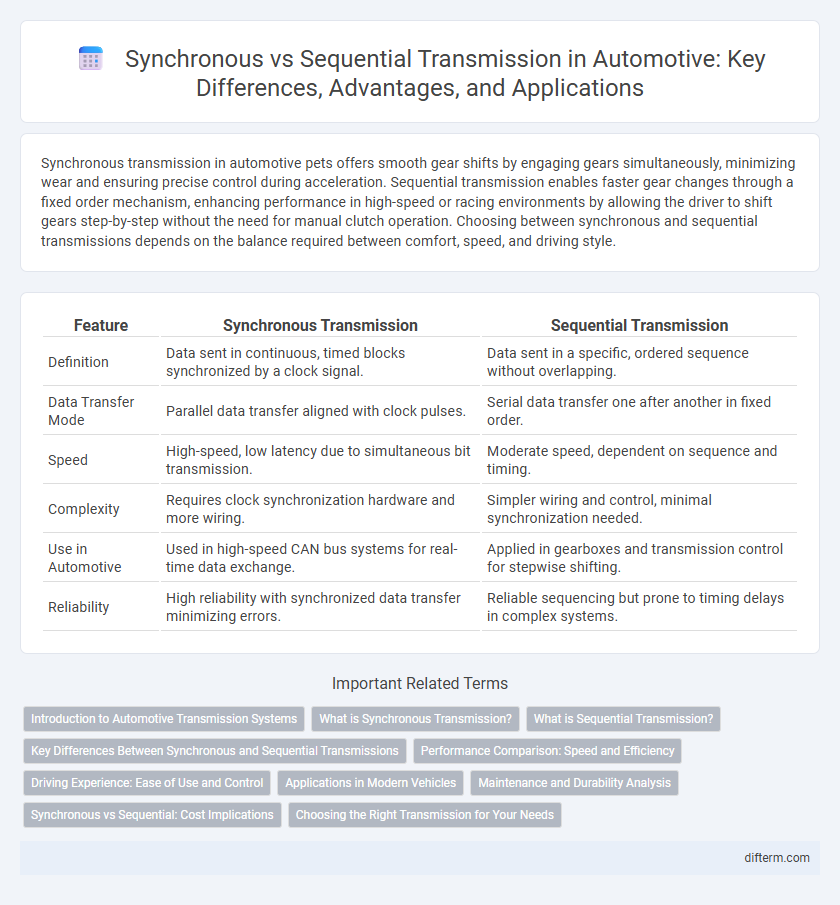Synchronous transmission in automotive pets offers smooth gear shifts by engaging gears simultaneously, minimizing wear and ensuring precise control during acceleration. Sequential transmission enables faster gear changes through a fixed order mechanism, enhancing performance in high-speed or racing environments by allowing the driver to shift gears step-by-step without the need for manual clutch operation. Choosing between synchronous and sequential transmissions depends on the balance required between comfort, speed, and driving style.
Table of Comparison
| Feature | Synchronous Transmission | Sequential Transmission |
|---|---|---|
| Definition | Data sent in continuous, timed blocks synchronized by a clock signal. | Data sent in a specific, ordered sequence without overlapping. |
| Data Transfer Mode | Parallel data transfer aligned with clock pulses. | Serial data transfer one after another in fixed order. |
| Speed | High-speed, low latency due to simultaneous bit transmission. | Moderate speed, dependent on sequence and timing. |
| Complexity | Requires clock synchronization hardware and more wiring. | Simpler wiring and control, minimal synchronization needed. |
| Use in Automotive | Used in high-speed CAN bus systems for real-time data exchange. | Applied in gearboxes and transmission control for stepwise shifting. |
| Reliability | High reliability with synchronized data transfer minimizing errors. | Reliable sequencing but prone to timing delays in complex systems. |
Introduction to Automotive Transmission Systems
Synchronous transmission in automotive systems uses synchronized gear engagement for smooth shifting and improved fuel efficiency, ideal for city driving and moderate acceleration. Sequential transmission offers rapid gear changes through a fixed gear sequence, enhancing performance and control in motorsport and high-performance vehicles. Understanding these transmission types is crucial for optimizing vehicle dynamics and matching drivetrain technology to driving conditions.
What is Synchronous Transmission?
Synchronous transmission in automotive communication refers to data transfer where bits are sent at regular intervals synchronized by a shared clock signal, ensuring precise timing and coordination between sender and receiver. This method enables high-speed, continuous data flow essential for real-time vehicle systems like engine control units (ECUs) and advanced driver-assistance systems (ADAS). Compared to sequential transmission, synchronous transmission reduces latency and improves data integrity, making it ideal for critical automotive applications requiring consistent timing.
What is Sequential Transmission?
Sequential transmission is a type of gearbox commonly used in motorsports and high-performance vehicles, allowing drivers to shift gears in a linear order without the need to manually select each gear individually. Unlike synchronous transmissions that rely on synchronizer rings to match gear speeds for smooth engagement, sequential gearboxes use a ratchet mechanism to enable rapid, precise gear changes by simply moving the shift lever forward or backward. This design enhances shifting speed, reduces wear on components, and improves overall transmission efficiency, making it ideal for competitive driving environments.
Key Differences Between Synchronous and Sequential Transmissions
Synchronous transmission in automotive applications involves data being sent at regular intervals, coordinated by a shared clock signal, enabling precise timing and reduced errors during gear shifting. Sequential transmission allows for gear changes in a fixed order without skipping gears, offering smoother and faster transitions ideal for performance vehicles. The key differences lie in synchronous transmission's clock-based coordination for data transfer and sequential transmission's mechanically ordered gear engagement for driving efficiency.
Performance Comparison: Speed and Efficiency
Synchronous transmission offers precise timing coordination that enhances overall speed by reducing latency in data exchange between automotive control units. Sequential transmission, while simpler, typically experiences slower data rates and increased processing delays due to its step-by-step data handling approach. Performance analysis reveals that synchronous transmission delivers higher efficiency and faster data throughput critical for advanced driver-assistance systems (ADAS) and real-time sensor integration.
Driving Experience: Ease of Use and Control
Synchronous transmission offers smooth gear shifts with minimal driver input, enhancing ease of use for everyday driving by automatically matching gear speeds. Sequential transmission provides more precise control by allowing manual gear selection in a fixed order, preferred in performance driving where quick and consistent shifts are crucial. The choice impacts driving experience by balancing convenience in city traffic and engagement on dynamic roads.
Applications in Modern Vehicles
Synchronous transmission in modern vehicles powers applications requiring precise timing, such as advanced driver-assistance systems (ADAS) and electric power steering, where coordinated signal exchange is crucial. Sequential transmission is predominantly used for infotainment systems and body control modules, enabling efficient data flow in predetermined order to manage displays, lighting, and comfort features. Both transmission types enhance vehicle communication networks, optimizing performance and reliability in connected automotive systems.
Maintenance and Durability Analysis
Synchronous transmissions feature precise gear engagement using synchronizer rings, reducing wear and extending component lifespan, which lowers maintenance frequency and costs. Sequential transmissions utilize a linear shift pattern that minimizes clutch wear and enables faster gear changes, improving overall durability but may demand specialized servicing due to their complex mechanism. In automotive maintenance analysis, synchronous systems generally offer easier repairs, while sequential transmissions require more expert attention but deliver enhanced performance under rigorous driving conditions.
Synchronous vs Sequential: Cost Implications
Synchronous transmissions typically incur higher manufacturing costs due to their complex design and precision-engineered components, which enhance gear engagement and reduce wear. Sequential transmissions offer a more cost-effective solution with simpler construction and faster shifting capabilities, making them favorable for performance-oriented vehicles. Assessing initial investment alongside long-term maintenance expenses is crucial when comparing these transmission types for automotive applications.
Choosing the Right Transmission for Your Needs
Choosing the right transmission depends on driving preferences and vehicle performance requirements. Synchronous transmission allows smoother gear shifts with precise timing, ideal for everyday city driving and fuel efficiency. Sequential transmission offers faster gear changes suited for high-performance vehicles and motorsport applications, enhancing acceleration and control.
Synchronous transmission vs Sequential transmission Infographic

 difterm.com
difterm.com